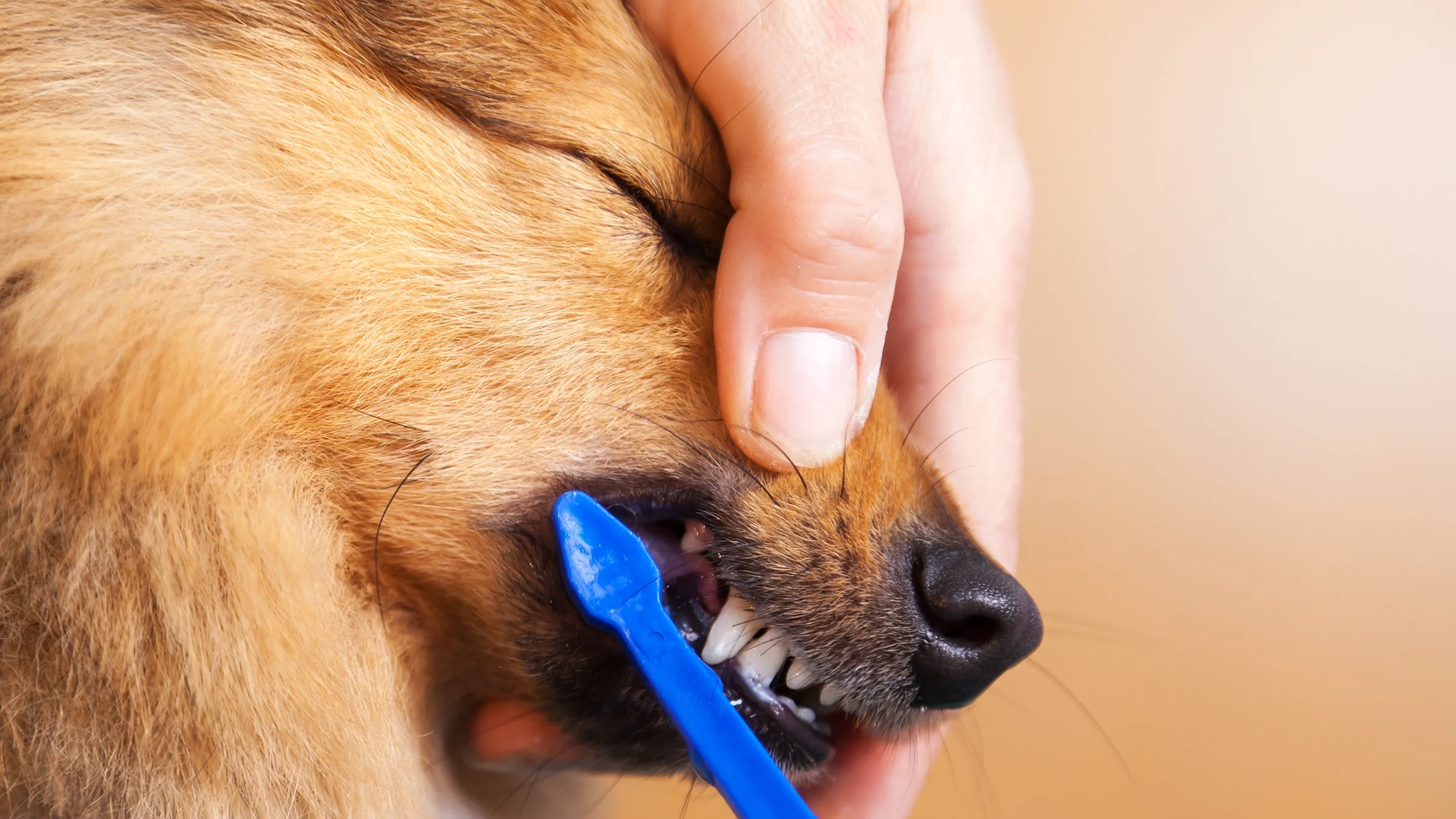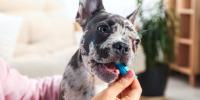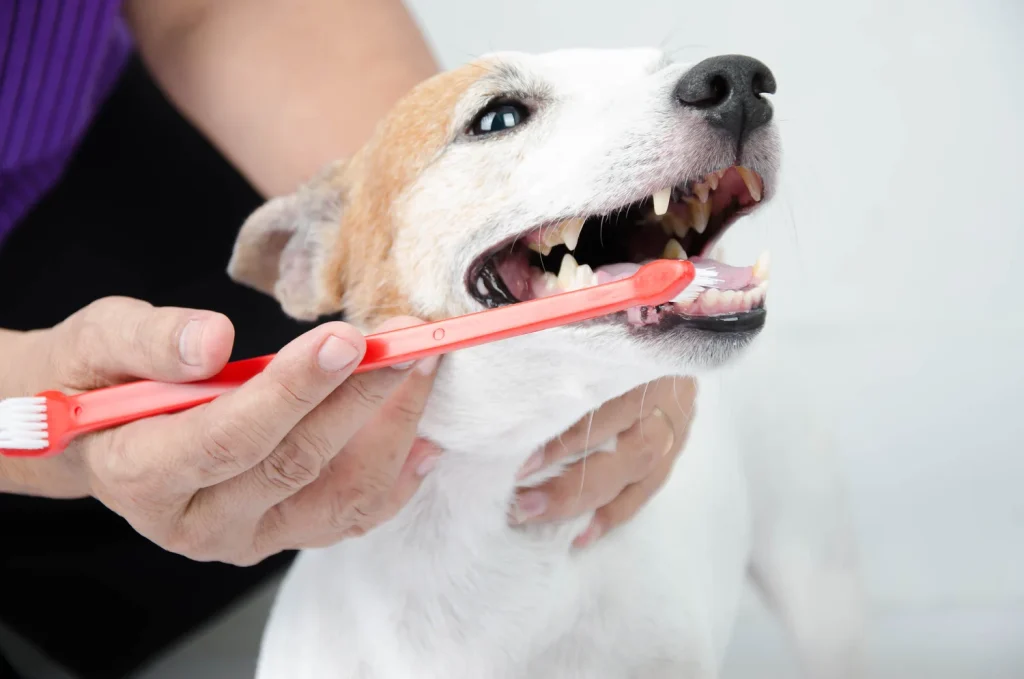Is brushing your dog’s teeth turning into a battle of wills? You’re not alone.
Many pet owners face the challenge of maintaining their furry friend’s dental health when their dog simply refuses to cooperate. But here’s the thing: you hold the key to unlocking a stress-free brushing routine that can transform this daunting task into a bonding experience.
Imagine a world where you no longer dread dental care time and where your dog willingly participates, wagging their tail. Intrigued? Keep reading to discover practical, easy-to-implement tips that will make brushing your dog’s teeth a breeze, ensuring their pearly whites stay healthy and bright. Your loyal companion deserves the best, and with the right approach, you can give it to them.

Credit: www.goodrx.com
Why Dog Dental Care Matters
Proper dental care keeps your dog healthy and happy. Dogs cannot tell you if they have tooth pain or gum problems. Regular brushing helps prevent serious health issues that start in the mouth.
Many dog owners miss this important task. Clean teeth improve your dog’s breath and overall well-being. Taking time to care for your dog’s teeth can add years to their life.
Health Risks Of Poor Dental Hygiene
Poor dental hygiene causes plaque and tartar buildup. This leads to gum disease and tooth loss. Bacteria from the mouth can enter the bloodstream. It may damage the heart, liver, and kidneys. Untreated infections cause pain and eating problems. Bad breath is a common sign of dental trouble.
Signs Of Dental Problems In Dogs
- Bad breath that does not go away
- Red, swollen, or bleeding gums
- Difficulty chewing or dropping food
- Loose, broken, or missing teeth
- Excessive drooling or pawing at the mouth
- Behavior changes like irritability or hiding
Watch for these signs to catch problems early. Regular checks and brushing keep your dog’s mouth clean and pain-free.
Choosing The Right Tools
Choosing the right tools makes brushing your dog’s teeth easier and less stressful. The right toothbrush and toothpaste can help your dog feel more comfortable. It also improves the cleaning process. Picking gentle and effective products helps protect your dog’s teeth and gums.
Types Of Dog Toothbrushes
Dog toothbrushes come in many shapes and sizes. Some have long handles to reach the back teeth. Others have soft bristles to protect sensitive gums. Finger brushes fit over your finger and give more control. Try different types to find what your dog accepts best.
- Standard toothbrush with soft bristles
- Finger brush for gentle cleaning
- Double-headed brush for different angles
- Electric toothbrush designed for dogs
Selecting Dog-friendly Toothpaste
Human toothpaste is harmful to dogs. Use toothpaste made specifically for dogs. These toothpastes are safe to swallow and taste better to dogs. Flavors like chicken or peanut butter can make brushing more enjoyable. Avoid toothpaste with fluoride or harsh chemicals.
- Enzymatic toothpaste to reduce plaque
- Pleasant flavors to encourage brushing
- Safe ingredients for dogs to swallow
- No foaming agents or fluoride
Preparing Your Dog For Brushing
Preparing your dog for tooth brushing helps build trust and ease anxiety. Dogs often resist brushing because it feels strange. Taking time to prepare your dog creates a positive experience. This phase sets the foundation for smoother brushing sessions.
Creating A Calm Environment
Choose a quiet place with few distractions. Soft lighting helps dogs feel relaxed. Speak in a gentle, soothing voice to calm your dog. Avoid rushing. Let your dog explore the area first. Sit or kneel at your dog’s level to appear less threatening. Keep sessions short to prevent stress. Calm energy encourages your dog to stay still and cooperative.
Introducing The Toothbrush Gradually
Start by letting your dog see and sniff the toothbrush. Use a finger or cloth to touch your dog’s lips and teeth gently. Reward your dog with praise or treats for calm behavior. Slowly move the toothbrush closer to the mouth over several days. Let your dog lick toothpaste from the brush to build interest. Practice brushing the outside of the teeth without pressure. Gradual introduction reduces fear and builds comfort with the toothbrush.

Credit: tomandtoto.co.uk
Techniques For Brushing Reluctant Dogs
Getting your dog to accept tooth brushing can be a real challenge, especially if they resist or get anxious. The key is to make the experience as comfortable and positive as possible for your furry friend. These techniques focus on patience, kindness, and creativity to help you brush your dog’s teeth even if they initially refuse.
Short And Gentle Sessions
Start with very brief brushing sessions—just a few seconds at first. Use a soft-bristled toothbrush and gentle strokes to avoid overwhelming your dog. Gradually increase the time as your dog becomes more comfortable, but never push too hard or force the process.
Remember, your goal is to build trust, not to finish a perfect cleaning in one go. Think about how you’d feel if someone suddenly tried to brush your teeth without warning.
Using Positive Reinforcement
Positive reinforcement works wonders with reluctant dogs. Praise your dog warmly and offer treats right after each brushing attempt, even if it’s just a quick touch of the brush. This helps your dog associate tooth brushing with good things.
Try pairing brushing with your dog’s favorite activities or toys. This makes the experience less about the brushing itself and more about the enjoyable routine surrounding it.
Distraction And Reward Methods
Sometimes distraction is the best tool. Use a lick mat smeared with peanut butter or yogurt to keep your dog’s attention while you gently brush their teeth. The tasty distraction encourages them to stay still without feeling stressed.
After brushing, reward your dog with a special treat or extra playtime. This reinforces the idea that good things happen after brushing, turning reluctance into cooperation over time.
Alternative Dental Care Options
Sometimes, brushing your dog’s teeth feels impossible because they simply refuse to cooperate. Luckily, you don’t have to give up on their dental health. There are other ways to keep your dog’s teeth clean and gums healthy without the daily brushing battle.
Dental Chews And Toys
Dental chews and toys can be a great alternative for dogs that resist brushing. These products help remove plaque and tartar through chewing action, which naturally scrapes the teeth.
Look for chews that carry the Veterinary Oral Health Council (VOHC) seal, as they meet specific standards for effectiveness. Toys made from tough rubber or nylon also encourage chewing, which massages gums and cleans teeth.
Have you noticed how your dog enjoys chewing their favorite toy for hours? This simple habit can actually support their oral hygiene. Just make sure to pick the right size and type so it’s safe and effective.
Professional Dental Cleanings
If home care isn’t working, professional dental cleanings are a reliable option. Veterinarians use specialized tools to remove plaque and tartar buildup safely and thoroughly.
These cleanings usually require anesthesia, but they ensure a deep clean that you can’t achieve at home. Regular visits can also help catch dental problems early before they become painful or serious.
Think about how you feel after a professional teeth cleaning—it’s refreshing and pain-free. Your dog deserves the same care, even if they don’t enjoy brushing. Talk with your vet about how often your dog should have this service based on their individual needs.
Common Challenges And Solutions
Brushing your dog’s teeth can feel like an uphill battle, especially when they resist or show fear. Understanding the common challenges helps you stay calm and find solutions that work for your furry friend. Let’s look at practical ways to handle aggression, fear, and resistance during teeth cleaning.
Handling Aggression Or Fear
Dogs may act aggressively or fearfully because brushing feels strange or uncomfortable. Approach your dog calmly and speak in a soothing voice to ease their anxiety.
Try letting your dog sniff and lick the toothbrush or toothpaste before starting. This simple step can make the process less threatening.
Reward your dog with treats or praise immediately after brushing to create a positive association. Consistency in this routine helps reduce fear over time.
Dealing With Resistance
Resistance often happens because your dog doesn’t like the taste or sensation. Experiment with different dog-friendly toothpaste flavors like chicken or peanut butter to find one your dog prefers.
Keep brushing sessions short—just a few seconds at first—and gradually increase the time. This prevents overwhelming your dog and builds tolerance.
If your dog struggles, try brushing one or two teeth at a time instead of all at once. Breaking the task into smaller steps can make it more manageable for both of you.

Credit: www.purina.com
Frequently Asked Questions
How Can I Calm My Dog Before Brushing Teeth?
Use gentle petting and soft words to relax your dog. Start with short sessions and reward with treats. Create a positive environment to reduce stress and resistance during brushing.
What Tools Help Brush A Dog’s Teeth Effectively?
Use a dog-specific toothbrush or finger brush with soft bristles. Choose toothpaste made for dogs, as human toothpaste can be harmful. These tools make brushing easier and safer for pets.
How To Brush Teeth If My Dog Resists Completely?
Try desensitization by gradually introducing the brush and toothpaste. Begin by letting your dog lick toothpaste from your finger. Increase brushing time slowly to build comfort and trust.
Can Dental Wipes Replace Brushing For Dogs?
Dental wipes can help remove plaque but don’t replace brushing. They are useful for dogs who resist brushing but should be used alongside regular brushing for best results.
Conclusion
Brushing your dog’s teeth takes patience and gentle care. Start slow and make it a calm routine. Use soft brushes and tasty toothpaste made for dogs. Praise your pet often to build trust. Small steps lead to healthier teeth and gums.
Keep trying even if your dog resists at first. A clean mouth helps your dog feel good every day. Regular brushing protects against pain and costly vet visits. Stay consistent and your dog will learn to enjoy it. Caring for your dog’s teeth is a simple way to show love.

